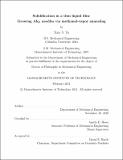Solidification in a thin liquid film : growing Alq₃ needles via methanol-vapor annealing
Author(s)
Yu, Tony S. (Tony Sheung)
DownloadFull printable version (5.817Mb)
Alternative title
Growing Alq₃ needles via methanol-vapor annealing
Other Contributors
Massachusetts Institute of Technology. Dept. of Mechanical Engineering.
Advisor
Anette E. Hosoi.
Terms of use
Metadata
Show full item recordAbstract
Organic electronics hold the promise of low-cost, flexible, large-area electronic and optoelectronic devices. In order to improve the performance of these devices, it is vital to control the morphology (e.g., the crystallinity) of these thin films. This thesis examines how solvent-vapor annealing of thin, amorphous films of Alq₃-i.e., tris-(8-hydroxyquinoline) aluminum-promotes the growth of single-crystal needles; we explore this system through experiments, modeling, and analytical scaling laws. The first part of this thesis describes the growth of single-crystal Alq₃ needles from amorphous, thin films of Alq₃ annealed in methanol vapor. Micrographs captured during annealing reveal needle lengths that grow like power laws, such that Lneedle ~ t[gamma]. We show that the growth exponent, [gamma], decreases when the thickness of the Alq₃ films is increased. In addition to needle growth, the fluid films exhibited dewetting and coarsening behavior: the initially-uniform films broke up into small drops that coalesced to form larger drops. In the second part of this thesis, we develop a mathematical model describing these morphological changes-both drop formation and needle growth-during solvent-vapor annealing. The evolution of the fluid films is modeled by a lubrication equation, and a convection-diffusion equation captures the transport of Alq3 and methanol within the films. We define a dimensionless transport coefficient, [alpha], which describes the relative effects of diffusion and coarsening-driven convection. Numerical simulations based on this 1D model reproduce the films evolution observed in experiments. The final part of this thesis describes scaling laws that govern needle growth. For large [alpha]-values, needle growth matched the theory of 1D, diffusion-driven solidification, such that [gamma]1/2. For low [alpha]-values, flow driven by drop collapses-i.e., coarsening-controls the growth of needles. Within this regime, we identify two cases: needles that were small compared to the typical drop size, and those that were large. For small needles, [gamma]-> 2/5, and for large needles, [gamma]-> 0:29. These scaling laws provide a simple physical picture of needle growth and match numerical simulations.
Description
Thesis (Ph. D.)--Massachusetts Institute of Technology, Dept. of Mechanical Engineering, 2011. This electronic version was submitted by the student author. The certified thesis is available in the Institute Archives and Special Collections. Cataloged from student submitted PDF version of thesis. Includes bibliographical references (p. 135-145).
Date issued
2011Department
Massachusetts Institute of Technology. Department of Mechanical EngineeringPublisher
Massachusetts Institute of Technology
Keywords
Mechanical Engineering.